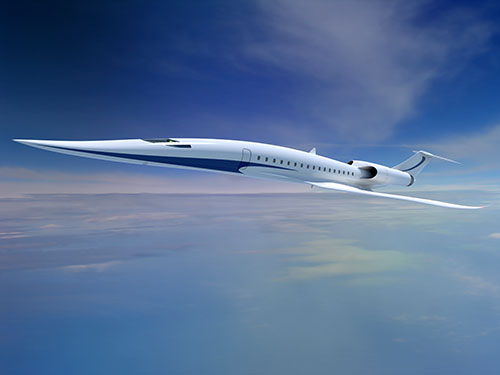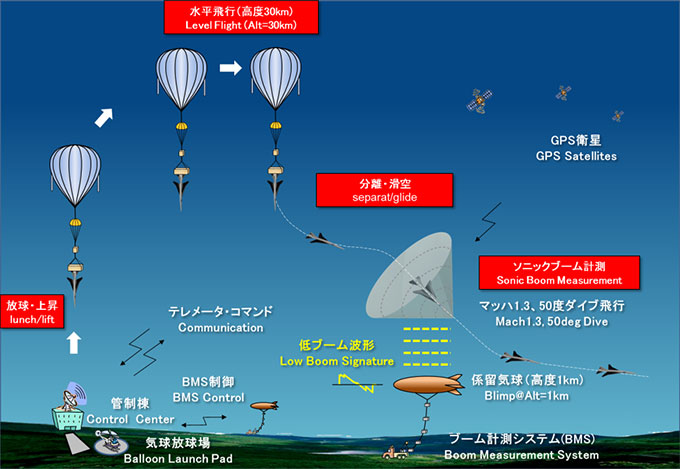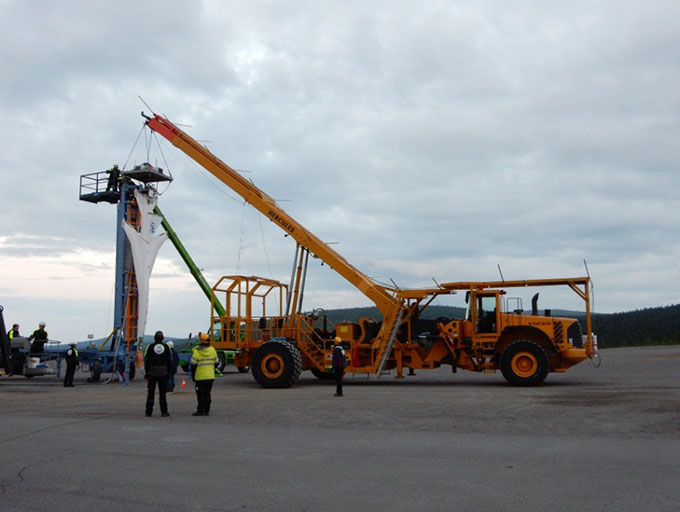Soheil_Esy
Fazanavard فضانورد
- Joined
- Apr 5, 2015
- Messages
- 744
- Reaction score
- 19
- Points
- 18
D-SEND project
Currently, airplanes fly at about Mach 0.8, which is markedly slower than the speed of sound. From Japan, which is distant from Europe and the United States, it takes more than 12 hours to fly the distance. If we were able to fly faster than the speed of sound, for example at twice the speed, then the time for flying would be halved and the flight duration from Japan to Europe or the United States would be about 6 hours. If the travelling time were shortened, then economic activities would be bolstered by increased opportunities for business and tourism. Moreover, measures against natural disasters could be taken quickly, thereby ushering in a safer and more affluent society. If the flight duration were less than 6 hours, then the increasing frequency of hazards, nuisances, and ailments such as economy-class syndrome could be prevented. Perhaps most importantly, everyone would be able to enjoy travel more comfortably than ever. These airplanes that enable high-speed transportation, which fly at a speed faster than the speed of sound, are called supersonic civil transport.
Although the realization of supersonic civil transport is highly anticipated, successors to the Concorde, which was retired in 2003, have not been forthcoming. Shortcomings of the Concorde included poor fuel consumption and extremely high operational costs. In addition, because sonic booms are created, supersonic flight over land was not permitted. Its routes were severely restricted, which is another reason that business success eluded the Concorde. During flight experiments in 2002–2005 using NEXST-1, a small supersonic experimental plane, JAXA demonstrated a technology to reduce air resistance and to improve fuel consumption efficiency. The D-SEND project first phase test was conducted in 2011. The second phase test was conducted in 2013, in an attempt to verify the concept of an airframe design technology for sonic boom abatement. As described, key technologies will be acquired to meet the requirements of supersonic passenger aircraft and to present JAXA's original low sonic boom design concept model, "Quieter supersonic civil transport".

Concept image of small supersonic passenger aircraft
http://www.aero.jaxa.jp/eng/research/frontier/sst/
Non-symmetrically Distributed sonic boom
July 27, 2015 (JST)
Japan Aerospace Exploration Agency (JAXA) conducted the second phase test of the “Drop test for the Simplified Evaluation of Non-symmetrically Distributed sonic boom” Project (D-SEND#2) at the Esrange Space Center in Sweden on July 24, 2015 local time. It has been confirmed that the supersonic experimental airplane successfully flew over the Boom Measurement System (BMS)*1, and that booms*2 generated from the airplane were measured by multiple microphones.
It is the world’s first successful flight test in which an experimental airplane designed with low sonic boom design concept to reduce both front and rear shock waves was flown at supersonic speed and had its sonic booms captured. As soon as detailed analysis of the BMS and flight data are completed, we will further report on our goal, which is to validate JAXA’s original low sonic boom design concept.
Technology to reduce sonic boom is considered to be one of the most challenging issues in realizing the future supersonic civil transport. The D-SEND Project aims to validate JAXA’s original low sonic boom design concept and to provide both design technology and data obtained through the flight test that will contribute to the deliberation of international standardization of sonic boom*3.
We would like to express our deepest gratitude towards the Swedish Space Corporation and other relevant parties for their fullest cooperation and support.
*1 The system to measure sonic boom not affected by atmospheric turbulence near the ground, by using multiple aerial microphones tethered to a blimp, which was developed during the first phase of this Project (D-SEND#1), conducted in May of 2011.
*2 Sonic boom: phenomenon where shock waves generated from aircraft cruising at supersonic speed are merged together and create enormous sound, much like explosion.
*3 At the Annual General Assembly of CAEP (Committee on Aviation Environmental Protection) a council of ICAO (International Civil Aviation Organization), scheduled to be held in 2016, international standardization on sonic boom will be discussed, in line with the development of future supersonic civil transport.
Test Outline
The Supersonic Experimental Airplane (S-cube Concept Model, or S3CM), developed using JAXA’s low sonic boom design concept to reduce both front and rear shock waves, is launched using a balloon system at Esrange Space Center in Sweden. At 30km altitude, the experimental airplane is separated from the balloon. Accelerating into supersonic speed during its free fall, at Mach 1.3 with flight path angle of 50 degrees, the airplane glides over the boom measurement system (BMS), and generated sonic boom will be measured.

D-Send#2 Test Sequence

D-SEND#2 Supersonic Experimental Airplane
Test Conditions
On July 24, 2015 local time, the test was conducted. The balloon was released at 4:43, and the supersonic experimental airplane was separated from the balloon at 10:00. The experimental airplane flew normally and was terminated safely within the test area.
Balloon Released At 4:42, July 24, 2015 (11:43 JST)
Separated At 10:00, July 24, 2015 (17:00 JST)
Separation Altitude 30.5 km
Velocity (measurement phase) Mach 1.39
Flight path angle (measurement phase) 47.5 degrees

Getting ready for balloon launch

Balloon launch
http://global.jaxa.jp/press/2015/07/20150727_dsend2.html
Video
http://jp.tomonews.net/256629700149248
Currently, airplanes fly at about Mach 0.8, which is markedly slower than the speed of sound. From Japan, which is distant from Europe and the United States, it takes more than 12 hours to fly the distance. If we were able to fly faster than the speed of sound, for example at twice the speed, then the time for flying would be halved and the flight duration from Japan to Europe or the United States would be about 6 hours. If the travelling time were shortened, then economic activities would be bolstered by increased opportunities for business and tourism. Moreover, measures against natural disasters could be taken quickly, thereby ushering in a safer and more affluent society. If the flight duration were less than 6 hours, then the increasing frequency of hazards, nuisances, and ailments such as economy-class syndrome could be prevented. Perhaps most importantly, everyone would be able to enjoy travel more comfortably than ever. These airplanes that enable high-speed transportation, which fly at a speed faster than the speed of sound, are called supersonic civil transport.
Although the realization of supersonic civil transport is highly anticipated, successors to the Concorde, which was retired in 2003, have not been forthcoming. Shortcomings of the Concorde included poor fuel consumption and extremely high operational costs. In addition, because sonic booms are created, supersonic flight over land was not permitted. Its routes were severely restricted, which is another reason that business success eluded the Concorde. During flight experiments in 2002–2005 using NEXST-1, a small supersonic experimental plane, JAXA demonstrated a technology to reduce air resistance and to improve fuel consumption efficiency. The D-SEND project first phase test was conducted in 2011. The second phase test was conducted in 2013, in an attempt to verify the concept of an airframe design technology for sonic boom abatement. As described, key technologies will be acquired to meet the requirements of supersonic passenger aircraft and to present JAXA's original low sonic boom design concept model, "Quieter supersonic civil transport".

Concept image of small supersonic passenger aircraft
http://www.aero.jaxa.jp/eng/research/frontier/sst/
Non-symmetrically Distributed sonic boom
July 27, 2015 (JST)
Japan Aerospace Exploration Agency (JAXA) conducted the second phase test of the “Drop test for the Simplified Evaluation of Non-symmetrically Distributed sonic boom” Project (D-SEND#2) at the Esrange Space Center in Sweden on July 24, 2015 local time. It has been confirmed that the supersonic experimental airplane successfully flew over the Boom Measurement System (BMS)*1, and that booms*2 generated from the airplane were measured by multiple microphones.
It is the world’s first successful flight test in which an experimental airplane designed with low sonic boom design concept to reduce both front and rear shock waves was flown at supersonic speed and had its sonic booms captured. As soon as detailed analysis of the BMS and flight data are completed, we will further report on our goal, which is to validate JAXA’s original low sonic boom design concept.
Technology to reduce sonic boom is considered to be one of the most challenging issues in realizing the future supersonic civil transport. The D-SEND Project aims to validate JAXA’s original low sonic boom design concept and to provide both design technology and data obtained through the flight test that will contribute to the deliberation of international standardization of sonic boom*3.
We would like to express our deepest gratitude towards the Swedish Space Corporation and other relevant parties for their fullest cooperation and support.
*1 The system to measure sonic boom not affected by atmospheric turbulence near the ground, by using multiple aerial microphones tethered to a blimp, which was developed during the first phase of this Project (D-SEND#1), conducted in May of 2011.
*2 Sonic boom: phenomenon where shock waves generated from aircraft cruising at supersonic speed are merged together and create enormous sound, much like explosion.
*3 At the Annual General Assembly of CAEP (Committee on Aviation Environmental Protection) a council of ICAO (International Civil Aviation Organization), scheduled to be held in 2016, international standardization on sonic boom will be discussed, in line with the development of future supersonic civil transport.
Test Outline
The Supersonic Experimental Airplane (S-cube Concept Model, or S3CM), developed using JAXA’s low sonic boom design concept to reduce both front and rear shock waves, is launched using a balloon system at Esrange Space Center in Sweden. At 30km altitude, the experimental airplane is separated from the balloon. Accelerating into supersonic speed during its free fall, at Mach 1.3 with flight path angle of 50 degrees, the airplane glides over the boom measurement system (BMS), and generated sonic boom will be measured.

D-Send#2 Test Sequence

D-SEND#2 Supersonic Experimental Airplane
Test Conditions
On July 24, 2015 local time, the test was conducted. The balloon was released at 4:43, and the supersonic experimental airplane was separated from the balloon at 10:00. The experimental airplane flew normally and was terminated safely within the test area.
Separated At 10:00, July 24, 2015 (17:00 JST)
Separation Altitude 30.5 km
Velocity (measurement phase) Mach 1.39
Flight path angle (measurement phase) 47.5 degrees

Getting ready for balloon launch

Balloon launch
http://global.jaxa.jp/press/2015/07/20150727_dsend2.html
Video
http://jp.tomonews.net/256629700149248
